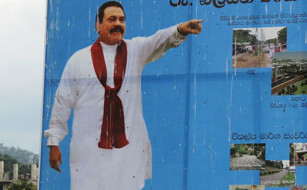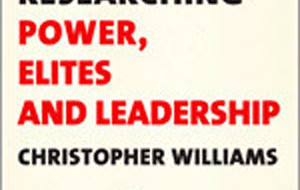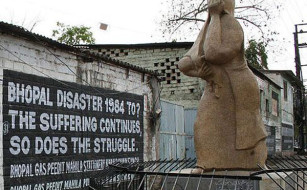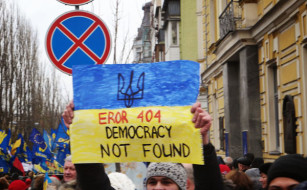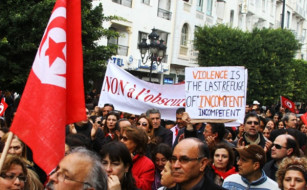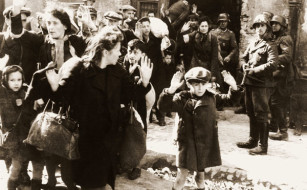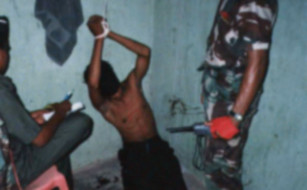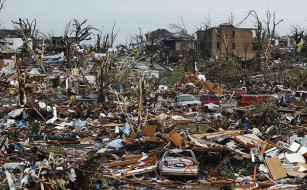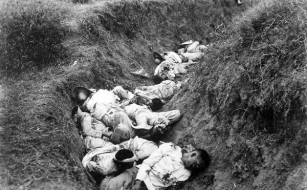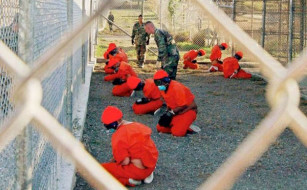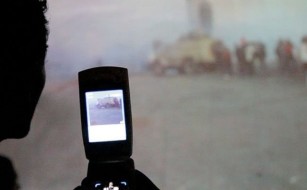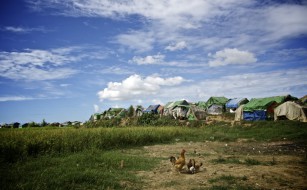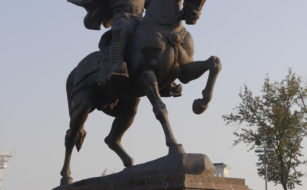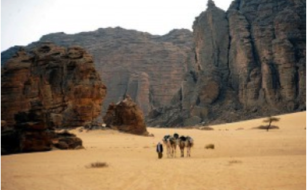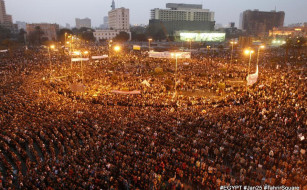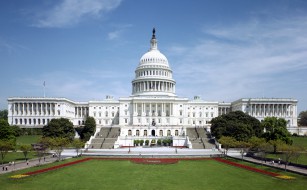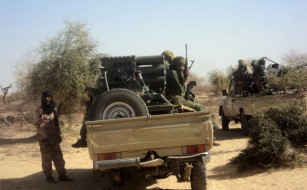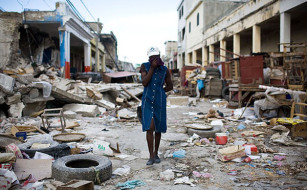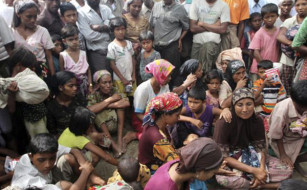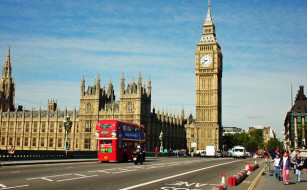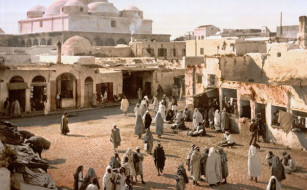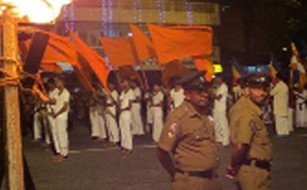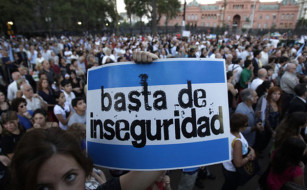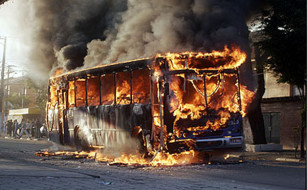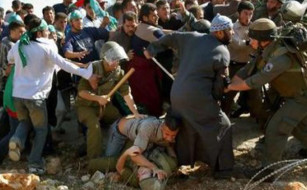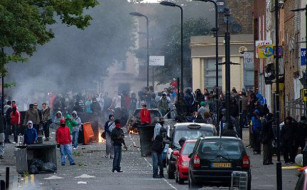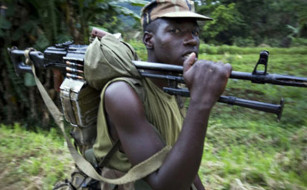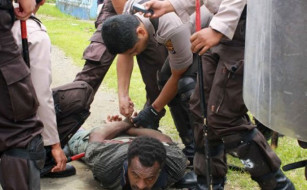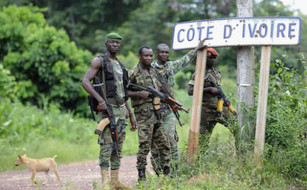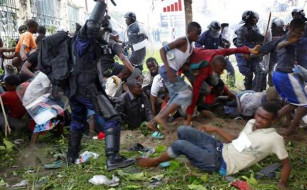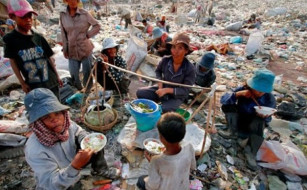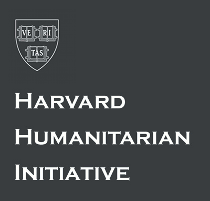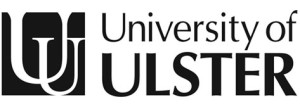Thank you Hillary! Secretary Clinton’s ‘emailgate’ revelations about Algerian state crimes
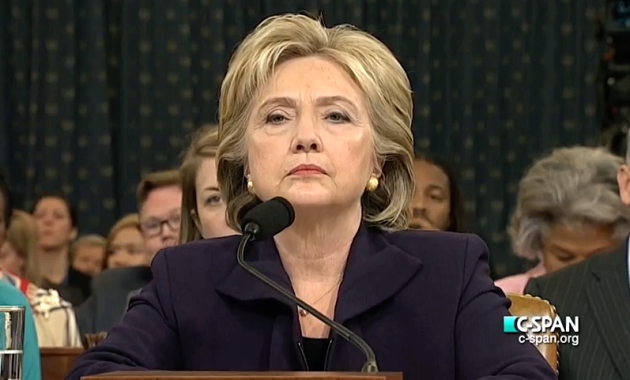
1.0 Introduction
During her term as US Secretary of State, from 2009 until 1 February 2013, Hillary Clinton used her family’s private email server for her official email communications, rather than official State Department email accounts maintained on federal government servers. This became public knowledge in March 2015 and was published by Wikileaks one year later on 16 March 2016.
The approximately 32,000 emails and 55,000 email pages contained on Clinton’s private server provide us with invaluable information on a range of subjects, which would probably not have come to light if she had not maintained her own separate communications system outside the control of the State Department and US intelligence services.
The purpose of this article is to reveal what Clinton’s private emails can tell us about Algeria, a key ally of the US in the US’s global war on terrorism (GWOT). They provide us with vital information on four interrelated subject areas. These are:
- The relationship between the Algerian authorities and internationally known terrorists, notably Mokhtar ben Mokhtar, who the Algerian, American and British authorities claim to have been behind the terrorist attack on the Tiguentourine gas plant at In Amenas in January 2013 that killed 40 foreign oil workers.
- The alleged Al Qaeda training camp at Tamouret (pseudonym), which, as I have previously documented,[1] was actually run by Algeria’s secret intelligence service, the Département du Renseignement et de la Sécurité (DRS), as a ‘counter-terrorism’ operation with the complicity of western intelligence forces.
- The presence of other Al Qaeda camps in Algeria, or rather, to be precise, Al Qaeda’s regional franchise, Al Qaeda in the Islamic Maghreb (AQIM).
- Algeria’s support for the Qadhafi regime in Libya during the course of the 2011 Libyan revolution, which has always been denied by both the Algerian and US administrations.
However, before turning to these specific issues, it is useful, especially for those not familiar with the details of ‘emailgate’, as the Clinton email controversy has become known, to provide a summary background of the circumstances by which these 32,000 emails have now been made publicly available by Wikileaks.
2.0 Background summary of the Hillary Clinton ‘emailgate’ controversy[2]
At the time of Senate confirmation hearings on Hillary Clinton’s nomination as Secretary of State, the domain names clintonemail.com, wjcoffice.com, and presidentclinton.com were registered to Eric Hoteham, with the home of Hillary and her husband, former president Bill Clinton, in Chappaqua, New York, as the contact address. The email server was stored in the Clintons’ Chappaqua home and maintained by a private computer technician employed by the Clintons.
Hillary Clinton never had a state-gov email account. Instead, she used the above domains, which were directed to her private server in her New York home, to send and receive emails.
It now transpires that over 60,000 emails passed through the server while Clinton was Foreign Secretary. Some 30,000 of these have been erased by Clinton on the grounds that they were private. We will probably never know what they contained. The remainder, some 32,000, have been handed over to the State Department.
As early as 2009, officials with the National Archives and Records Administration (NARA) expressed concerns over possible violations of normal federal government record-keeping procedures at the Department of State under Secretary Clinton.
Emails sent to Clinton’s private clintonemail.com address were first discovered in March 2013, when a hacker named “Guccifer” illegally accessed Sidney Blumenthal’s email account and widely distributed emails he had sent to Clinton.
Blumenthal (67) is an American journalist, activist and writer specialising in American politics and foreign policy. He served as an assistant and then senior advisor (1997-2001) to President Clinton, and is a long-time confidant of the Clintons, especially Hillary. After her appointment as Secretary of State, Hillary Clinton wanted to hire Blumenthal. However, President Obama’s chief of staff blocked this. Nevertheless, Blumenthal continued to serve Hillary and is reported to have received some $120 thousand per annum from the Clinton Foundation by way of recompense. He does not hold any official position in the government or administration and has not done so since Bill Clinton’s departure from the White House. Nor did he have security clearance when he obtained and sent material to Hillary Clinton that has since been classified as ‘classified’ by the State Department
Many Washington insiders believe that Ms Clinton, if elected, will select Blumenthal to serve on her administration. Ken Silverstein, another American journalist who last year described Blumenthal as “damaged goods” and as “one of the most dishonest, amoral political hatchet men of modern political times,” qualified his remark by adding that “he is damaged in large part because of his dirty work on Ms. Clinton’s behalf.”[3]
In the summer of 2014, State Department lawyers, while reviewing documents requested by the House Select Committee on Benghazi, noticed a number of emails from Clinton’s personal account. This led to a request by the State Department for additional emails and, after negotiations with Hillary Clinton’s lawyers and advisors, to some 55,000 printed pages of emails from Clinton’s personal email account being delivered to the State Department in December.
In March 2015, a New York Times article broke the story that the House Select Committee on Benghazi had discovered that Clinton had exclusively used her own private email server rather than a government-issued one throughout her time as Secretary of State, and that her aides took no action to preserve emails sent or received from her personal accounts as required by law. At that point, Clinton announced that she had asked the State Department to release her emails.
The legality of ‘emailgate’, as it soon became known, is complex and controversial. State Department spokesperson Marie Harf is reported as saying the use by government officials of personal email for government business is permissible under the Federal Records Act (FRA), so long as relevant official communications, including all work-related emails, are preserved by the agency. The Act (which was amended in late 2014, after Clinton left office, to require that personal emails be transferred to government servers within 20 days) requires agencies to retain all official communications, including all work-related emails, and stipulates that government employees cannot destroy or remove relevant records. Clinton and/or her aides may be in trouble on this latter aspect of the FRA, rather than the actual use of a private server per se.
Dan Metcalfe, a former head of the Justice Department’s Office of Information and Privacy, said: “She managed successfully to insulate her official emails, categorically, from the Freedom of Information Act (FOIA), both during her tenure at State and long after her departure from it – perhaps forever”, making it “a blatant circumvention of the FOIA by someone who unquestionably knows better.”
According to Wikipedia’s analysis of the issue, “Experts such as Metcalfe agree that these practices are allowed by federal law, at least in case of emergencies, but discourage the practice, believing that official email accounts should be used. Jason R. Baron, the former head of litigation at NARA, described the practice as “highly unusual but not a violation of the law.” In a separate interview, he said, ‘It is very difficult to conceive of a scenario—short of nuclear winter—where an agency would be justified in allowing its cabinet-level head officer to solely use a private email communications channel for the conduct of government business.” Baron told the Senate Judiciary Committee in May 2015 that “any employee’s decision to conduct all email correspondence through a private email network, using a non-.gov address, is inconsistent with long-established policies and practices under the Federal Records Act and NARA regulations governing all federal agencies.”
A further section of the Wikipedia analysis reports that “nearly 2,100 emails contained in Clinton’s server were retroactively marked classified by the State Department, though they were not marked at the time they were sent. 65 emails were found to contain information classified as ‘Secret’, more than 20 contained ‘Top-Secret’ information, and the rest contained ‘Confidential’ information.Clinton personally wrote 104 emails, and her aides authored hundreds of emails, that contained information that was later determined to be classified.”
It seems that the main point of contention in the controversy is whether Clinton passed information through her mail server that was classified at the time. If she did so, it would be improper because it was a private, non-secured channel.
A June 29, 2015 memorandum from the inspector general of the State Department, Steve A. Linick, said that a review of the 55,000-page email release found “hundreds of potentially classified emails”. A July 17, 2015 follow-up memo, sent jointly by Linick and the Intelligence Community (IC) inspector general, I. Charles McCullough III, to Under Secretary of State for Management Patrick F. Kennedy, stated that they had confirmed that several of the emails contained classified information that was not marked as classified. A transmittal memorandum, written by Kennedy, said that, “based on an assessment of a small sample of the contents of Mrs. Clinton’s private account by the two Inspectors General, it was likely that the entire body of emails contained hundreds of instances of classified information.” On July 24, 2015, Linick and McCullough said they had discovered classified information on Clinton’s email account, but did not say whether Clinton sent or received the emails. They said that classified information in the emails had originated from U.S. intelligence agencies, such as the CIA and the NSA (National Security Agency), and that it is illegal for anyone to receive a classified document, or briefing, and then summarise or otherwise transmit that information in an unclassified email. Their statement said that the information they found was classified when sent, remained so as of their inspection, and “never should have been transmitted via an unclassified personal system”.
While Clinton and her campaign have reiterated that the information transmitted was not classified “at the time”, the inspectors general, as well as reporting by the New York Times and others, said that it, in fact, was classified at the time.
In a further letter from McCullough to Congress on January 14, 2016, the IC inspector general stated that an unnamed intelligence agency had made a sworn declaration that several dozen emails [had been] determined by the IC element to be at the CONFIDENTIAL, SECRET, and TOP SECRET/SAP levels.
At the request of the IC inspector general, the matter is currently being subjected to a FBI probe. As part of this probe, Clinton agreed to hand over her email server to the US Department of Justice, along with thumb drives containing copies of her work-related emails.
Evidence subsequently provided (March 2016) by John Schindler, a former member of the National Security Council (NSC), a former Professor of National Security Affairs at the US Naval War College at Newport, Rhode Island, and a security consultant, confirmed “Team Clinton’s gross mishandling of highly classified NSA intelligence.”[4]
A key figure in ‘emailgate’ is Blumenthal. Schindler has identified a number of documents sent to Clinton by Blumenthal as being sensitive. Referring to one such email on the Sudan, dated 8 June 2011, Schindler describes Blumenthal as “a private citizen,” who at the time he sent “the particularly highly sensitive document to Hillary, had enjoyed no access to U.S. intelligence for over a decade.” Schindler went on to say that “this information was illegally lifted from four different NSA reports, all of them classified ‘Top Secret / Special Intelligence.’ Worse, at least one of those reports was issued under the GAMMA compartment, which is an NSA handling caveat that is applied to extraordinarily sensitive information (for instance, decrypted conversations between top foreign leadership, as this was). […] Currently serving NSA officials have told me they have no doubt that Mr. Blumenthal’s information came from their reports. ‘It’s word-for-word, verbatim copying,’ one of them explained. ‘In one case, an entire paragraph was lifted from an NSA report’ that was classified Top Secret/Special Intelligence.”
Schindler went on to question how Blumenthal got his hands on this information. “The fact that [Blumenthal] was able to take four separate highly classified NSA reports – none of which he was supposed to have any access to – and pass the details of them to Hillary Clinton via email only hours after the NSA released them in Top Secret/Special Intelligence channels indicates something highly unusual, as well as illegal, was going on, ” Schindler said.
2.i. Chronology of discovery and release of emails
The chronology of the discovery and release of the emails into the public domain is as follows:
On December 5, 2014, Hillary Clinton’s office submitted printed copies of 30,490 work-related emails to the State Department in response to an October records request issued to four former Secretaries of State. The correspondence, which amounted to some 55,000 printed pages, represented less than half of the 62,320 emails sent and received from Clinton’s private email account while she was Secretary of State from March 2009 to February 2013.
On March 10, 2015, while attending a conference at the UN Headquarters in New York, Clinton spoke with reporters for about 20 minutes. She said that she had used a private email for convenience, “because I thought it would be easier to carry just one device for my work and for my personal emails instead of two.” It was later determined that Clinton had used both an iPad and a Blackberry, while Secretary of State. She told the reporters that her staff would be turning over copies of 30,000 emails from her private server from her time at the State Department that she believed belonged in the public domain. She said that another 32,000 emails from the server from that same time period, that she regarded as personal and private, had been deleted.
The State Department began releasing the emails in May 2015 as a result of a Freedom of Information Act request. The emails were made available in the form of thousands of PDFs.
The final PDFs were made publicly available on February 29, 2016.
On March 16, 2016 Wikileaks launched a searchable archive for 30,322 emails & email attachments sent to and from Hillary Clinton’s private email server while she was Secretary of State.[5] The 50,547 pages of documents span from 30 June 2010 to 12 August 2014. 7,570 of the documents were sent by Hillary Clinton.
The FBI began its probe into the Clinton emails in July 2015. On 1 April 2016, the US State Department said it had halted its internal review of Clinton’s emails until the FBI’s more comprehensive security review of Clinton’s emails is complete. State Department spokesperson Elizabeth Trudeau said: “We do not want our internal review to complicate or impede the FBI probe. We are prioritizing the law enforcement investigation.”
ABC news reported (1 April) that “the FBI is expected to interview Clinton’s closest aides and the presidential candidate may also be part of the investigation. It is not clear when the investigation will be completed. The FBI has not formally named Clinton as a target and she has not [yet] been accused of any crimes.”[6]
The outcome of the FBI probe is eagerly anticipated in the context of the 2016 presidential election process.
Asked on 27 March (2016) whether she could reassure Democrats that the investigation was not going to escalate over the course of the campaign, Clinton said, “Absolutely I can.”[7]
Asked at a Democratic town hall hosted by Fox News if she had been informed by the FBI that neither she nor her aides were the target of the bureau’s probe, Clinton replied: “Absolutely true”.
Critics noted the only way Clinton could have that knowledge was through contact with the FBI, an event that apparently had not taken place at the date of those statements, nor at the time of the writing this article (3 April 2016).
On 27 March, the Washington Examiner reported that the FBI “had not contacted Hillary Clinton about her use of a private email account while she was secretary of state.”[8]
Though the FBI’s probe is approximately nine months old, the agency said it is sifting through findings. David Hardy, head of the FBI’s FOIA office, calling it an “active and ongoing investigation,” told the Washington Examiner: “the FBI is continuing to assess the evidentiary value of any materials retrieved for the investigation from any such server equipment/related devices.”[9]
In its court filing, the FBI also said it had obtained more of the material that Clinton stored on a private server in her basement, but that releasing the material would impede its investigation. Hardy said: “Materials that were retrieved from any server equipment and related devices obtained from former Secretary Clinton for the investigation … are potential evidence in the FBI’s investigation, or may provide leads to or context for potential evidence.”
2.ii. The implications of Hillary Clinton’s emails
There are a many implications to Ms. Clinton’s emails, some of which may scarcely have yet been realised.
The most obvious is in the form of a question, namely what impact will ‘emailgate’ have, if any, on this year’s presidential elections? However, I will not comment further on that at this stage, as we are dealing with too many highly speculative possible scenarios.
Even if the FBI recommends prosecution of Ms. Clinton or members of her inner circle for mishandling of classified information, which, as John Schindler noted, “is something the politically unconnected routinely do face prosecution for, it is by no means certain that the Department of Justice will follow the FBI’s lead.[10]
A second implication, raised by John Schindler, is that Clinton’s insistence on the use of her own electronic devices in a Secure Compartment Information Facility (SCIF) is potentially a major threat to national security. This is why electronic communications devices, such as a Blackberry or any form of phone, always need to be locked up before entering a SCIF, whether that SCIF be the US State Department or London’s Foreign & Commonwealth Office (FCO).
A third implication is that Ms Clinton’s mishandling of large amounts of classified information has put lives at risk.
At least 22 of Ms Clinton’s ‘Top Secret’ emails have not been released by the State Department. According to Fox News, they included “operational intelligence” that involves espionage sources and methods, adding, as Schindler has emphasised, “that lives have been put at risk by Hillary’s mishandling of this information.”[11]
As Schindler emphasised, “Discussions with Intelligence Community officials have revealed that Ms. Clinton’s ‘unclassified’ emails included Holy Grail items of American espionage. … Hillary’s emails also include the names of foreigners who are on the CIA payroll, according to Intelligence Community officials. Since it can be safely assumed that several foreign intelligence agencies intercepted Ms. Clinton’s unencrypted communications, this directly threatens the lives of the exposed individuals. ‘It’s a death sentence,’ explained a senior Intelligence Community official. … At a minimum, valuable covers have been blown, careers have been ruined, and lives have been put at serious risk.”[12]
Fourthly, Clinton’s emails have revealed a great deal of extremely sensitive secret information about a number of the US’s allies (and other countries) which those countries, as well as US government departments, such as State and Defence, as well as Intelligence agencies, have been at pains to keep secret.
3.0 What Clinton’s emails tell us about Algeria’s collusion with terrorists
Shortly after the attack on the Twin Towers Trade Centre in New York on 9 September 2001 (‘9/11’), the US and Algerian administrations entered into a largely covert agreement, which can be best described as one of ‘mutual assistance’. Algeria would provide President George Bush’s administration, notably various Pentagon and intelligence agencies, with information and operational assistance in the US’s GWOT. The US, in exchange, would assist Algeria, which had suffered a decade or so of international sanctions and isolation due to its ‘Dirty War’ of the 1990s between the army and Islamists, in re-equipping its technologically run-down military forces and rehabilitating Algeria – as America’s ally – into the international community. In short, Algeria became a close US ally in the GWOT.
The background to this agreement and how it was implemented are documented in my book, The Dying Sahara: US imperialism and Terrorism in Africa.[13] That book, along with some 200 or so other articles, reports and presentations[14] have detailed how the US (and other western allies) have colluded with Algeria, through false-flag terrorist operations and other forms of deception and/or exaggeration, to create an entirely false picture of terrorism in much of North West Africa – the Maghreb, Sahara and Sahel region. As a result of these activities, the Pentagon’s initial portrayal[15] in 2003 of this vast region of Africa as a ‘Terrorist Zone’ or ‘Corridor’ has become a self-fulfilled prophecy.
The original purpose of this strategy, which was first put into operational practice in late-2002 and 2003, was to enable the Bush administration to launch a new or ‘second’ front, often known as the Saharan-Sahel front, in the GWOT. Its aim then was to secure US access to African resources, notably oil. Since then, the aim of such operations has morphed and taken on new objectives, such as to justify the establishment in 2008 of a new, independent US military command for Africa, namely US AFRICOM. Since then, the security situation in the Sahara-Sahel region has rapidly worsened as the US-Algerian collusion with ‘terrorists’ has grown out of control and taken on a life and dynamic of its own.
It should be mentioned that while the term ‘Algerian authorities’ could refer to almost all branches of government, it refers almost exclusively to the country’s intelligence and security service, the Département du Renseignement et de la Sécurité (DRS), which was the main, if not sole, Algerian agency involved in most of these operations. This is because the DRS, during the presidency of Abdelaziz Bouteflika (1999- ) increasingly became a state-within-a-state, with its director, General Mohamed ‘Toufik’ Mediène, from 2004 onwards, and especially from 2009 (the start of Hillary Clinton’s term as Secretary of State) until the DRS’s demise in 2013, being the most powerful man in Algeria. As explained below, it is doubtful whether either the Bouteflika presidency or the Chief of Staff of the army, General Gaïd Salah, were fully aware of the DRS’s involvement with the region’s terrorist leaders and how it colluded with them. The US administration, however, especially through the Pentagon and intelligence agencies, worked closely with the DRS and, as John Schindler has confirmed,[16] was fully aware of the DRS’s collusion with terrorist leaders, such as Al Qaeda’s Mokhtar ben Mokhtar (see below) and Abdelhamid abou Zaïd (see below).
The response of Algeria, the US and its Western allies, notably the UK, to my claims, allegations and evidence, has been to deny, ignore or try and disparage them, and, as far as possible, to censor or prohibit their publication.
In the beginning (staring in 2003), as I was working alone in the central Sahara and Sahel, and was the sole witness to many of these covert and criminal activities, it was difficult to provide collaborative evidence. It was therefore relative easy for the various authorities to dismiss my work.
However, over the course of the last dozen or more years, an increasing amount of evidence of these ‘crimes’ has gradually come to light, especially during and since 2013.[17]
Much of this more recent evidence has come to light following and as a result of a major terrorist incident in the Algerian Sahara. In January 2013, terrorists attacked the large Tiguentourine gas facility near In Amenas. The siege lasted 4 days, at the end of which 40 foreign oil workers, along with some 30 terrorists and nine Algerians had been killed.[18] The Algerian, US, British and French authorities attributed the attack to Mokhtar ben Mokhtar (Belmokhtar)(MBM), an Algerian, internationally proscribed terrorist.
MBM was not present during the In Amenas attack and his role in organising it remains uncertain and largely unproven. More importantly, there is a growing body of evidence to suggest, as I have argued, that the In Amenas siege was another false-flag terrorist operation, but one that went disastrously wrong. During the London inquest (2014-2015) into the deaths of seven British nations, the UK authorities ensured that none of this evidence was admitted to court. The authorities insisted that the attack was the work of MBM.
Hillary Clinton’s emails are immensely helpful in that they provide further important evidence of the role of MBM in the Tiguentourine (In Amenas) siege. They also add further confirmation to several of my other claims regarding the collusion of the DRS and US intelligence services in terrorism.
The following four sections describe and analyse the information that Ms. Clinton’s private emails provide on four interrelated subject areas.
3.i. Mokhtar ben Mokhtar’s secret agreement with the Algerian authorities
In January 1992, Algeria’s rulers, comprising mostly senior army generals, undertook an effective coup d’état by annulling the national legislative elections which were on the brink of bringing to power the world’s first ever democratically elected Islamist government.
The immediate consequence of this coup d’état was a civil war, known as the ‘dirty war’, between the Islamists and the army, which lasted until 1999. Some 200,000 people lost their lives. Three features of this war were the extreme nature of violent atrocities against civilians; the fact that many of these atrocities were undertaken by the Algerian army and its DRS masquerading as Islamists; and that the DRS had succeeded so well in infiltrating the armed Islamist groups (GIA) that many of the key incidents of the war, such as the hijacking of an Air France Algiers-Marseilles airbus (1994), the Paris Metro bombings (1995) and many of the civilian massacres in Algeria, are now known to have been ‘false-flag’ operations.
Although the Dirty War of the 1990s had diminished considerably by 1999, terrorism in Algeria was not totally eradicated. An estimated 600-1,000 militants, now belonging to the Groupe salafiste pour le predication et le combat (GSPC), later to change its name in 2006 to AQIM, continued their war against the Algerian state. The extent to which the GSPC/AQIM leadership was infiltrated by the DRS, as in the 1990s, is debatable. My own on-going research into terrorism and militancy in Algeria, from 1999 to the present day, corroborated by John Schindler’s 2012 insights from US intelligence agencies,[19] confirms that the relationship between the terrorist groups, or at least their leaders, and the DRS remained largely intact and has continued – in the form of several ‘false-flag’ operations – at least up to 2013.
From the time of the first major post-9/11 false-flag operation in Algeria in 2003, when 32 European tourists were taken hostage by a group of GSPC terrorists led by a DRS agent, Aberrezak Lamari, (a.k.a. ‘El Para’),[20] until the January 2013 terrorist attack on the Tiguentourine gas plant near In Amenas, the name of Mokhtar ben Mokhtar (MBM)(Belmokhtar) has been portrayed by the Algerian authorities and the US government, as one of the region’s leading terrorists, if not ‘the’ leading terrorist. MBM has often been likened in the Algerian and western media to the ‘Sahara’s Bin Laden’.
MBM has been almost universally condemned, at least by the Algerian, US, UK and French authorities, as being behind the Tiguentourine attack (and many other such terrorist actions). Apart from my own writings on the subject, and John Schindler’s 2012 corroboration, there has been no other serious question raised in open-source literature as to whether MBM is or was associated in some way or another with the Algerian authorities and/or its DRS.
Amidst Ms. Clinton’s 32,000 emails, there are two emails that are particularly pertinent in regard to MBM’s relationship to the Algerian authorities. The first was dated 17 January 2013, the second day of the Tiguentourine siege.[21] It was sent to Hillary Clinton by Sidney Blumenthal. Entitled ‘Latest French Intelligence Reports on Algerian Hostage Crisis’, the email says the following about the Tiguentourine attack that was supposedly led or initiated by MBM:
“According to a very sensitive source, individuals with access to officers of the French external intelligence service (Direction Générale de la Sécurité Extérieure – DGSE) working in Mali and Algeria during the January 17, 2013 hostage crisis, stated in private that the Algerian government of President Abdelaziz Bouteflika was surprised and disoriented by the attacks. According to sources with access to the Algerian DGSE [JK ed. Blumenthal means DRS], the Bouteflika government reached a highly secret understanding with Belmokhtar after the kidnapping in April 2012 of the Algerian consul in Gao (Mali). Under this agreement Belmokhtar concentrated his operations in Mali, and occasionally, with the encouragement of the Algerian DGSE (JK ed. DRS), attack Moroccan interests in Western Sahara, where the Algerians have territorial claims.”
The second key email, also sent by Blumenthal to Clinton on 19 January 2013 and entitled ‘Algeria Latest French Intel.’, provides something of a debriefing on the Tiguentourine crisis.[22] For example, it is learnt from a source:
“with access to the highest levels of the Algerian army that the commanders of the Special Forces consider the mission [operation] a success.”
The same email also tells us that:
“According to this sensitive source, officers of the Algerian DGSE (DRS) are looking to secretly meet Belmokhtar or one of his lieutenants in northern Mauritania in the immediate future. They have been ordered to find out why Belmokhtar violated their two year old secret agreement and launched attacks in-side Algeria.”
The key points of these two emails are:
- i) There is confirmation from high level intelligence sources, probably members of or in contact with the French DGSE, that there was a secret agreement between the Bouteflika government and MBM. My own understanding of the situation is that this agreement was reached very much earlier, possibly around 2001-2003. However, it might well have been reconfirmed in April 2012, and quite possibly on several other occasions between those dates.
Although probably immaterial as far as Blumenthal’s information is concerned, there is evidence, documented in The Dying Sahara,[23] that the kidnapping in Gao on 6 April 2012 of the Algerian consul, Boualem Sias, and six of his staff, almost certainly DRS officers, may have been another false-lag operation, undertaken by the DRS and designed to give the impression that Algeria was a victim of the Islamist insurgency in Mali, rather than its instigator and backer. It is not clear whether MBM or another DRS agent, such as Abdelhamid abou Zaïd of Yahia Djouadi (a.k.a. Abou Al-Hammam, Jemel Okacha), carried out the kidnapping. Neither has the resolution of the kidnapping ever been made clear, which is not surprising under these circumstances.
- ii) It is clear that the relationship between the Algerian authorities and MBM was such that the Algerian authorities, who, from the context of the source, we take to be the top command of the army, clearly presumed that it could order the DRS to meet with MBM and find out why he had broken the secret agreement. There is no hint that the army or DRS was considering going after MBM and either killing him or capturing him and bringing him to trial for the death of so many foreign nationals.
This brings us to the key question of why the Bouteflika government, according to the sources cited in these emails, could not understand why MBM had apparently broken their secret agreement.
The reason for this, as I have repeatedly documented, is that the DRS at this time was operating as a state-within-a-state. It is almost certain that neither the presidency nor the army command, although they may have had suspicions, knew that the DRS was running its own clandestine ‘false flag’ and other such operations in collaboration with terrorist leaders such as MBM, Abdelhamid abou Zaïd and Yahia Djouadi.
Although certainly known to some western intelligence sources in the US and UK, the Algerian presidency and its army command, which by this time were almost at ‘daggers drawn’ with the DRS and its boss, General Mediène, were probably not fully aware of the real nature of the relationship between MBM and the top commanders of the DRS, notably Mediène (now dismissed) and General Hassan, who, as explained below, is now in prison.
In short, as I have contended from the outset, the attack on Tiguentourine was almost certainly a false-flag operation, planned by the DRS (Generals Mediène and Hassan) and carried out on their behalf by MBM’s group, which went disastrously wrong. MBM knew full well that the real power in Algeria at that time was the DRS, not the presidency or the army, and that if he wanted to safeguard his massive trans-Saharan commercial trafficking interests and other clandestine activities, he needed to remain on good – i.e. collaborative – terms with the DRS, who were his ultimate protectors.
We therefore had a situation in Algeria where the Algerian presidency, the army high command and, I contend, western oil companies, knew there was a secret agreement with MBM not to attack installations within Algeria. The DRS, which would have been the agency that made the deal with MBM, would have assured the presidency and army command that such an agreement had been made. What neither the presidency, army nor foreign oil companies knew (although they may have suspected) was that they had effectively been double-crossed by the DRS, the intelligence agency with which the US and British authorities was so closely associated, to the extent that the DRS used MBM and other terrorist leaders, such as Abou Zaïd, to undertake false-flag operations as and when the DRS deemed them strategically useful for its own agenda, as in the case of Tiguentourine (In Amenas). Hence the Algerian government’s surprise at MBM’s involvement in the In Amenas attack.
While the Algerian government, in the form of the presidency and army chief of staff, may have been surprised, there are three reasons why the US, UK and possibly also the French authorities would not have been. One is because of their close working relationship with the DRS. A second is because John Schindler, the senior US intelligence officer, had blown the whistle on this sort of scenario in 2012.[24] The third was because I had personally briefed the US State department and intelligence agencies, in Washington, on the relationship between the DRS and terrorist organisations in both 2006 and 2008,[25] while the British authorities were fully aware of these relationships through briefing meetings at the FCO.[26],. The response to the evidence presented was one of dismissal, thus raising the question of the extent to which they may be held to account for complicity in terrorism. Indeed, this is the question that is addressed in more detail in my Report on In Amenas.[27]
As for the follow-up meeting by DRS officers with MBM to find out what had led him to break his agreement, it is unlikely that it ever took place. That is because three of the terrorists survived the Tiguentourine siege, only to be captured by the army in a roadblock shortly afterwards. Under interrogation, they confirmed that General Hassan had armed them. At that point, the army command and the presidency would have known the truth of what happened at Tiguentourine, namely that it was another DRS false-flag operation, but one that had gone wrong.
The question of why the DRS undertook the In Amenas operation, goes beyond the purpose and scope of the article. A full explanation is given in my Report on In Amenas.[28] However, the following nine paragraphs provide a brief summary of this explanation.
The most likely motive, which was documented in some detail in The Dying Sahara (2013) before the In Amenas attack actually took place, related to an incremental falling out between Algeria, or rather its DRS, and the Western powers of the US, UK and to a lesser extent France.
In the year or two before the Libyan Revolt of 2011,[29] relations between Algeria and its Western allies became increasingly tense. By around 2010, the US and UK, who by then had both developed close ‘counter-terrorism’ alliances with the DRS, were becoming increasingly anxious at the extent to which the DRS had so thoroughly infiltrated AQIM. Not only were local people in the region actually referring to AQIM and the DRS as one and the same organisation, but the West was also becoming increasingly anxious about the nature and scale of the DRS’s involvement in an array of criminal activities, notably drug trafficking and hostage-taking.
The problem of allowing such a dangerous relationship to develop and continue was not simply that it raised the question of US and UK complicity in terrorism, but that both countries had become so dependent on Algeria’s DRS for their regional intelligence that they were unable to distinguish between disinformation and ‘truth’ and so discern what was really going on in the region. For Western intelligence services, truth and fiction became conflated in a sea of disinformation, with the result that by around 2010, and probably much earlier, ‘the tail’, to use a colloquialism, in the form of the DRS, ‘was wagging the dog.’
By mid-2011, the relationship between Algeria and the West – notably the US and UK, but also France – became particularly fraught, as the NATO allies came to learn that Algeria, its supposed ally in the GWOT, was covertly supplying the Qadhafi regime with substantial support (see below).
Then, in the following year (2012), the West could do little more than read reports of how the DRS, its partner in counter-terrorism, was supporting the Islamist incursion in Mali.
By the latter part of 2012, the DRS knew that its relationship with these Western powers was coming under review. It therefore sent a warning to the West, in the form of an article published in the Algerian daily newspaper El Khabar on 12 November 2012, just over two months before the In Amenas attack.
The article, written by a ‘journalist’ who was known to have close links to the DRS, had all the hallmarks of being a warning to the West, reminding it that Algeria was the only country in the region that could really counter terrorism, whether fabricated or real, and also had the means and the preparedness to fight such terrorism. In short, the DRS sought to remind the West that it was the West’s appointed gendarme in the region and that it should not abandon it lightly.
It was a warning that the West either ignored, or, because of its own inadequate intelligence, simply failed to see and understand. The result was that the DRS, either using MBM, or working directly with another DRS operative, Mohamed Lamine Bouchneb, who was closely connected to MBM, planned for ‘terrorists’ to take foreign nationals hostage as they were leaving Tiguentourine on the escorted bus to In Amenas airport. The hostages would subsequently be released by a fabricated army rescue operation or a ‘ransomed’ release, in the same way as the DRS had successfully managed two similar ‘false flag’ operations in 2003. However, the plan went wrong, because, it appears, the attackers encountered unexpected resistance from the gendarmes guarding the two buses exiting the plant. At that point the plan began to unravel. Bouchneb’s men entered the complex to find other hostages, but soon became trapped there by the surrounding security forces.
This explanation of events must always remain a state secret, by both Algeria and its western allies. The consequences in Algeria have been drastic. The DRS has been effectively dismantled and lost its name. Mediène has been dismissed, but remains under summary threat of a whole possible range of charges being brought against him, while Hassan is in gaol after a very hasty secret trial that lasted less than one day.
Following the revelation in Hilary Clinton’s private emails of the agreement between the Algerian authorities and MBM, the Mediterranean-centred TV channel Medi1 TV ran an investigative report into this new information on the In Amenas attack on 24 March (2016) on its programme “60 Minutes to Understand”.[30]
In doing so, the Channel played the audio intercepts of the terrorists made during the final day of the In Amenas siege. These were first made available by the Japanese newspaper Nikkan-Gendai on 5 December 2015.
Japan had 10 of its citizens, employees of JGC, killed at In Amenas, making its losses greater than any other nation. On 5 December 2015, almost three later, Nikkan-Gendai, published audio intercepts that it had acquired from the final deadly battle in the Tiguentourine plant. They indicate that the terror group believed it had a safe-harbor understanding with Algerian military commanders.
One section of the audio recording includes the voice of a terrorist named Abdul Afman saying, “The army has violated the pledge and has deceived us! They [the Algerian army] have struck the vehicles carrying the hostages and our friends, and everyone was killed!”.
Another of the terrorists, Abderrahman, is heard transmitting a distress call shouting “The Algerian (government) doesn’t keep its word!”
Experts invited by Medi1 TV to comment on the Nikkan-Gendai audio intercepts and the Clinton emails concluded that “there can be no doubt that the terrorist group was bound by a tacit agreement with the Algerian authorities.”
So far, the Algerian authorities, not surprisingly, have not responded to either the Clinton emails or the Medi1 TV programme and analysis.
3.ii. Confirmation of the existence of the Al Qaeda/DRS terrorist training camp
One of the most closely guarded secrets of the global war on terror is ‘Tamouret’. The name ‘Tamouret’ is a pseudonym for a location in the extreme south of Algeria where the DRS ran a supposedly AQIM training camp.
I had passed very close to the location of the Tamouret camp on several occasions between 2003, when I believe it was being planned, and 2005 and 2006 when my suspicions were raised by army patrols blocking my passage into the Tamouret region. Although I had heard vague reports of such a camp from local, semi-nomadic Tuareg tribesmen, it was not until after 2009 that I was able to confirm its existence and build up a fairly detailed picture of what went on in it.
Without divulging its precise location, let me say that it was in SE Algeria, in the Tassili-n-Ajjer region, to the east of Ahaggar. I first mentioned Tamouret in 2013 in The Dying Sahara.[31] A more recent description and analysis of the training camp is given in my 2016 Report on In Amenas: inquest cover-up and Western involvement in Algerian state crimes.[32] Tamouret appears to have been closed around 2009 at about the same time as AQIM increased its activities in northern Mali.
Through subsequent interviews with occupants of the camp, it is clear that the camp was run by local Algerian leaders of AQIM, notably Abdelhamid abou Zaïd and Abdullah al Furathi, but under the overall control and management of top Generals of the DRS.
The camp’s purpose was to press-gang, indoctrinate and train marginalised youths, in various degrees of alienation from their communities across North Africa, the Sahel and even further afield, to commit atrocities in Algerian communities with whom they had no connection. They were generally executed after they had performed their tasks, or before if they gave any hint of dissent. These youths (they were often mere teenagers) were seen as utterly disposable, much as the Iranians regarded the peasant children they sent across Iraqi minefields in the 1980s.
Those who remained in the camp (i.e. not killed) numbered, at any one time, about 270. The majority were Algerians, but witness interviews identified nationals from almost right across the Arab-Muslim world, from Mauritania and Morocco in the west to the Horn of Africa, Central Asia and Afghanistan in the east.
Training was basically in two fields: snipping and throat-slitting (égorgement). Snipers were the elite and had greater freedoms and privileges within the camp. The most common form of killing was throat-slitting, or what was called in Arabic al-mawt al-baTii’ (‘the slow death’).
Prisoners, to be killed as part of the training process, were delivered to the camp by the Algerian army/DRS in a more or less continual flow (on average 4 times a week). Witness interviews described how an average of 2-3 persons were executed in training every 3-4 days, with those killed including army officers and soldiers, who had presumably stepped out of line or were deemed ‘suspect’, as well as ‘civilians’ or ‘common criminals’, from the prisons. These latter, I believe, comprised many of les disparrus, the thousands who disappeared at the hands of the Algerian regime in its ‘dirty war’ of the 1990s.
One witness claims to have seen some 180 murders undertaken in this way during his seven-month stay in the camp. The dead bodies were disposed of by burial details. With the help of colleagues, some of these graves have now been located and investigated, with the dead bodies and skeletal remains (along with accompanying data and evidence) being recorded photographically.
It is inconceivable that American and British intelligence agencies, who were working hand in glove with the DRS during these years, could not have known what was going on at Tamouret. Moreover, Tamouret was almost certainly a major asset to Western intelligence agencies. As recruits arrived at the camp, their identities, including photographic recognition and, it is believed, DNA, were recorded by DRS officers. This data was dispatched to Algiers where it is believed to have been shared with US and British intelligence agencies, both of whom had close working relations with the DRS.
Through the West’s counter-terrorist relations with Algeria’s DRS, the Tamouret operation would appear to have provided the West with the identities of hundreds, possibly thousands, of Al Qaeda ‘terrorists’. This may explain why so many terrorist attacks were reportedly foiled during these years. If that were the case, Tamouret might be deemed as having been a brilliant counter-terrorism operation. However, its success, if that is what it was, was predicated on a monstrous crime: the cold-bloodied murder of hundreds, if not thousands, of innocent victims. It is for this reason that its presence, and western complicity in its operation, will always be denied.
The first of the two emails cited above, from Sidney Blumenthal to Hillary Clinton,[33] provides what I believe is corroborative evidence of the camp.
Section 5 of the email is given over to what Blumenthal calls ‘the Belmokhtar groups’. This is an attempt to convey what he knows of the leaders and operating locations of other terrorist groups in the region. One of these he calls the ‘Abu Zayd Group’. He is, in fact, referring to Abdelhamid abou Zaïd, a DRS agent or operative, who, until his reported death in 2013, was head of AQIM in the Sahara-Sahel region.
Blumenthal writes as follows:
“Abu Zayd Group: The Abu Zayd faction is currently one of the principal subgroups of AQIM …. The group is deeply committed to the jihadist struggle against what it sees as the “secularism” of Tunisia and Morocco. The Abu Zayd group is based in southern Algeria and northern Mali, under the direction of Abid Hamadu (also known as: Abou Abdellah, Abdelhamid Abu Zied, Youcef Abdel, and Abu Abdellah). This Group is one of the most active and important of the AQIM member groups, and it has the resources, personnel, and flexibility to support operations into Western Sahara and Morocco.
“According to very sensitive sources, Abu Zayd is based in the Hoggar (Ahaggar) Massif, in the Tamanrasset region. (Note: This is a rugged mountainous plateau located 1,000 miles from the Atlantic Ocean, lying mostly in southern Algeria, on the Tropic of Cancer). On the eastern edge of this region, the Abu Zayd Group is active in assisting Islamic fighters traveling to the Horn of Africa, Iraq, and even Afghanistan. In the south it has established relationships with tribal leaders in central Africa, relationships that allow AQIM to move freely in and out of the sub-Saharan region.”
These two paragraphs require considerable interpretation. They demonstrate Blumenthal’s own lack of knowledge of Algeria’s Saharan regions and his total reliance on his sources. (For example, Ahaggar is not a plateau and is nearer to 1500 miles from the Atlantic’s nearest margin. Interestingly, the Tassili, which is the location of Tamouret, is a plateau.). In this email his sources are described in the following words: “According to a very sensitive source, individuals with access to officers of the French external intelligence service (Direction Générale de la Sécurité Extérieure – DGSE)” …. “sensitive sources with access to the Algerian army” …. “sources with access to the Algerian DGSE (ed. JK. DRS).”
These sources are vague and unspecific. They sound more like hearsay, coming, most likely from Blumenthal’s political/intelligence associates either in or with close access to relevant elements within the French intelligence services (who had good knowledge of what was going on in the Sahara-Sahel region at this time), the Algerian regime and, from the context of this section of the email, also Morocco.
Blumenthal’s report on Abou Zaïd contains two very illuminating sentences. First, Blumenthal’s sources tell him that Abou Zaïd is based in Ahaggar (JK. ed. in the Tamanrasset region, which is both the name of the province/wilaya and its capital town). Secondly, Blumenthal is told that the Abou Zaïd group is active on the eastern edge of this region (i.e. Ahaggar) in “assisting Islamic fighters traveling to the Horn of Africa, Iraq, and even Afghanistan.”
Abou Zaïd, in his capacity as a ‘terrorist’ (rather than a DRS operative), was not and could not have been based in Ahaggar for reasons, relating to local ethnographic data, that are too particular and detailed to explain here.
In his capacity as a DRS operative, it is almost certain that Abou Zaïd would have visited and probably spent much time in the town of Tamanrasset, which is now a garrison town and the major DRS centre for southern Algeria. However, as I shall explain in the next section, Blumenthal’s information, which has to be interpreted within the context of his own lack of geographical knowledge of the region, although technically incorrect on that specific point, is correct and extremely revealing in the wider scheme of things.
The second and most illuminating sentence is Blumenthal’s reference to the Abou Zaïd group being “active on the eastern edge of this region in assisting Islamic fighters traveling to the Horn of Africa, Iraq, and even Afghanistan.” This can only be a reference to ‘Tamouret’, which is just to the east of the eastern edge of Ahaggar. Neither Blumenthal nor even his sources would have been likely to know the name of Tamouret (which is a pseudonym). That is because it is not near any town, village or other easily identified landmark. Also, its name, as used by its occupants, was an Arabic code word.
Moreover, Blumenthal’s use of the word ‘assisting’ is a slight misnomer. Rather, they had come from these far-away regions to be given specialist ‘terrorist’ training, mostly in killing methods, and would then, in all probably, be assisted in their return to them.
Nevertheless, the fact that Blumenthal’s sources have flagged up this operation is telling. It can be nothing other than the Tamouret training camp. Moreover, we do not know what further details Blumenthal was given by his sources, but did not include in this email. It is most likely that they would have pointed out to him the precise or approximate area of Tamouret on a map. But, as it is located far from any named landmark, and with Blumenthal’s clear lack of knowledge of the region, he would have been correct in describing it in the way he did: on the eastern edge of Ahaggar.
3.iii. The presence of other Al Qaeda camps in Algeria
The working relationship between Algeria’s DRS and AQIM receives further corroboration from an email from Blumenthal to Ms. Clinton in May 2011, during the time of the Libyan rebellion.[34] The key paragraph in the email reads as follows:
“These same individuals with access to Saïf al Islam add that groups of fighters loyal to al Qa’ida in the Islamic Maghreb (AQIM) have taken advantage of the fighting between rebel and government forces to establish a presence among some of the tribes located in the remote Southwestern part of Libya. At the same time AQIM operatives have established a central base close to the southern reaches of the Algerian Hoggar [JK ed. Ahaggar] Mountains, from which they are directing katabats [JK. ed. ‘brigades’ of up to approx. 100 fighters] in the following locations:
“Northern Mali, in the village of Taoudeni; Eastern Mali, in the town of Gao; Niger in the town of Tahoua. The operational area for AQIM’s Katibat(s) is the region that runs along the borders of: Mali-Niger; Niger-Algeria; Niger-Libya.”
The importance of this seemingly innocuous passage is its date: May 2011. Tamouret closed down around 2009, with many of Abou Zaïd’s AQIM fighters moving south into the Sahel. Then, in February 2010, the Algerian authorities banned all tourism travel in much of the Ahaggar and Tassili regions, but especially the Tassili-n-Ahaggar region. Local Tuareg were even prohibited entry into this area. The name Tassili-n-Ahaggar would be unfamiliar to anyone, such as Blumenthal, who did not have detailed knowledge of the local topography and its nomenclature. It is the eroded Tassili (which means plateau) range immediately to the south of Ahaggar (which Blumenthal calls Hoggar), between southern Ahaggar and the Niger frontier.
The Algerian authorities said ‘security’ was the reason for the closure. Local Tuareg knew that was not true, as there were no ‘terrorists’ in that area. They therefore assumed it was a cover for some sort of planned ‘land clearance’ by the Algerian authorities. The rumour at the time was that the Algerian authorities were allowing Chinese mining companies to have free range to prospect through the Tassili-n-Ahaggar, an environmentally sensitive area, and did not want local Tuareg seeing and reporting on the environmental damage being inflicted.
However, Tuareg soon realised that that was not the case and that it was the Algerian military and DRS who had taken over the region. By late 2010, local Tuareg who had managed to enter the region told me they were fairly certain that the seven French hostages, seized by AQIM from the Areva-owned uranium mines at Arlit in northern Niger in September 2010 were being held captive in this area, under the protection of the Algerian military/ DRS for their own safety.[35] In February 2011, an Italian tourist, travelling alone, was abducted 130 kms south of Djanet and 90 kms north of the Niger border and, according to local Tuareg sources, also taken into the adjoining Tassili-n-Ajjer region, where she was also held hostage.[36]
Although firm evidence was hard to come by at the time, it was rapidly becoming clear that the Tassili-n-Ahaggar region had been taken over by the Algerian military and DRS to provide some sort of shelter or base for Abou Zaid’s AQIM, which the DRS could manage and provision (from Tamanrasset), and from which the DRS and AQIM could control their expanding activities in the Sahel – notably Niger and Mali, without fear of attack from Nigerien, Malian, or, worse still, French or other foreign units operating under cover in the Sahel region.
Blumenthal’s reference to this central AQIM base, “close to the southern reaches of the Algerian Hoggar Mountains,” could be nothing other than the protected facilities given to AQIM by the Algerian DRS and military in the Tassili-n-Ahaggar.
In short, this email provides further corroborative evidence of the close working relationship between Algeria’s DRS and AQIM.
3.1v. Algeria’s support for the Qadhafi regime in the Libyan rebellion (2011)
Almost from the onset of the NATO (French, British and US) military intervention in Libya in March 2011, there were reports of Algerian assistance to the Qadhafi regime, which is something that both Algeria and the US have always denied.
The Algerian regime feared that Qadhafi’s fall could precipitate its own overthrow. Elements within the Algerian regime, notably the DRS, therefore set out to prolong the Qadhafi regime’s hold on power. Algeria’s initial strategy was to try to persuade the West that Qadhafi’s son, Saïf al-Islam, was an acceptable solution. That, however, only lasted a few weeks, until Saïf revealed his true colours. It then tried to convince the West that the only solution for Libya was a partition of sorts between East and West. That too, following the fall of Misrata and then Tripoli, came to naught. It was then left with its final strategy, one in which it is most adept: to create as much confusion and chaos as possible.
Algeria’s support for Qadhafi was extensive. It first sent detachments of irregulars to bolster Qadhafi’s forces.[37] These were first identified in the western Libyan town of Zawiyah where some of them were captured and identified by anti-Qadhafi forces. Spokesmen of the National Transitional Council (NTC) later reported the capture of 15 Algerian mercenaries and the deaths of three others in fighting near Ajdabiya. The same sources also reported Algeria’s DRS employing many of the private security forces and Republican Guard of deposed Tunisian President Zine El Abidine Ben Ali and sending them to Libya to shore up Qadhafi.[38] Many of these units were previously used as snipers to assassinate demonstrators in Kasserine, Sidi Bouzid and Thala in Tunisia. Then, following the defection of Libyan pilots to Malta in the early stages of the conflict, and prior to the authorisation of the UN ‘No-Fly zone’ on March 17, Algeria sent 21 of its pilots to the Mitiga air base in Tripoli. There were also numerous reports of Algerian military transport planes airlifting mercenaries from sub-Saharan Africa. Data collected from the air traffic control tower at Benghazi’s Benina airport ascertained that there had been 22 flights by Algerian aircraft to Libyan destinations between February 19 and 26. Some were listed as Air Algérie and were possibly evacuating nationals. Most, however, were listed as ‘special flights’ by aircraft bearing registration codes used by the Algerian military. These records show repeated flights by C-130 Hercules and Ilyushin Il-76, aircraft big enough to carry battle tanks. Destinations included the airports at Sebha and Sirte. By March, in a memorandum to the Arab League, the NTC had put the number of Algerian flights that had landed at Tripoli’s Mitiga airport at 51. The memorandum said the shipments included ammunition, weapons and Algerian and mercenary fighters.
Then came the definitive evidence. On April 18, Alain Juppé, the French foreign minister, confronted Algeria with evidence discovered by French military advisers working with the Libyan rebels that a number of military jeeps and trucks used by Qadhafi’s forces, which had been abandoned after a military battle, carried serial numbers which identified them as French military equipment that had been sold to Algeria.
Algeria’s actions irritated the UK and US governments so much that Algeria’s foreign minister Mourad Medelci was ‘invited’ to meet the US Secretary of State, Hillary Clinton, in Washington.[39] Behind the bonhomie of the official press releases, sources reported that Medelci was castigated for Algeria’s support for Qadhafi.
Algeria, however, does not take kindly to being rebuked and immediately dispatched one of its rougher political apparatchiks, Sadek Bouguetaya, to address Qadhafi’s meeting of Libyan tribes in Tripoli on May 8. In a rabble-rousing speech, Bouguetaya voiced Algeria’s unconditional support for Qadhafi and blasted NATO’s Libyan operations, which he likened to the attempts of Paul Bremer, the former US administrator in Iraq, to control Baghdad. He called Qadhafi’s effort to stay in power heroic and criticised the West for its bombing of the civilian population. With specific reference to Algeria’s War of Independence, Bouguetaya said that he had confidence that the Libyan people would defeat France, as the Algerian revolutionary forces had done in 1962.
At the same time that Bouguetaya was haranguing NATO in Tripoli, the Libyan ambassador to Algeria publicly announced that his embassy had purchased 500 ‘military grade’ vehicles from Algerian dealers, with more in the pipeline, to help Qadhafi ‘s forces.
Washington was not pleased by Algeria’s belligerence. On May 18, the Emir of Qatar, Sheikh Hamad bin Khalifa al-Thani, described by Robert Fisk[40] as “the wisest bird in the Arabian Gulf,” paid a one-day visit to Algiers. Sheikh Hamad’s message to his Algerian counterpart is believed to have been two-fold. One was that Qatar, which was the key Arab state in the NATO alliance, and by implication Algeria’s “other friends” were disappointed at Algeria’s lack of meaningful political reform. The other, as Robert Fisk reported a few days later, was to try to ‘persuade’ the Algerian regime from resupplying Qadhafi with tanks and armoured vehicles. Indeed, one reason suggested by Fisk for the ridiculously slow progress of the NATO campaign against Qadhafi was because Algerian armour of superior quality had been replacing the Libyan material destroyed in air strikes.[41]
Even though the US and its NATO allies were angered by Algeria’s support for Qadhafi, the US consistently denied in public that Algeria was assisting Qadhafi. The ultimate public denial came on 1 June when General Carter Ham, Commander of US AFRICOM, was flown to Algiers to deliver a highly publicised speech in which he said he “could see no evidence” of Algerian support for Qadhafi.
General Ham’s disingenuous statement was part of a ‘package deal’ believed to have been worked out between top officials in the US and French governments and Algeria’s DRS.[42] The talks had two main strands. One was to save the Algerian regime from the same fate as Tunisia’s Ben Ali, Egypt’s Mubarak and soon, it was presumed, Qadhafi by encouraging it to move more rapidly towards meaningful political reform. The other was to effectively rehabilitate the Algerian regime with NATO and the Pentagon. The deal was both a re-affirmation of the strategic importance of Algeria to the US and a reminder to both sides that they shared too much ‘recent history’ in regard to their joint activities in the GWOT for them to fall out. In short, neither the US nor Algeria could afford to have their secrets and cooperation aired in public.
The essence of the deal was that Algeria would cease its support for Qadhafi, while the US would save Algeria from international condemnation by reiterating General Carter Ham’s “see no evidence” of Algerian support for Qadhafi. It was agreed that Algeria would also desist from linking Libya’s rebels with Al-Qaeda and Islamic extremism, which was both irksome and embarrassing to the NATO alliance. In exchange, the US would back Algeria’s scare mongering over the threat AQIM presented to Algeria, the wider region and Europe, as well as its grossly exaggerated and largely unverified statements about arms flows from Libya to AQIM.
Although Algeria and the US persisted with their denials of Algerian assistance to Qadhafi, the Clinton emails provide ample corroborative evidence of the fact that Algeria was, in fact, helping Qadhafi and that the US, in spite of General Ham’s famous ‘I can see no evidence’ speech, was fully aware of what Algeria was doing.
The two clearest emails were those sent from Blumenthal to Hilary Clinton on 28 February 2011 and 18 April.
The first of these emails,[43] entitled “Up to minute detailed state of play politically and militarily”, said the following:
“highly reliable source stated in confidence that African mercenaries continue to land in Tripoli, passing through the airport of Sebha (410 miles south of Tripoli) which is still in the ends [JK ed. Hands] of Qaddafi loyalists. These troops are flown in on aircraft belonging to the Libyan Company, Afriqiyah Airways. Until February 24 these forces were recruited in Nigeria, Chad, Benin; however, beginning on February 25 the recruits began to include fighters from Algeria, including troops from the Frente Popular de Liberacion de Saguia el Hamra y Rio de Oro (Polisario Front.) (Source Comment: These Polisario troops are drawn from the Saharawi people fighting against Morocco for the independence of the territory of Western Sahara. These Polisario troops have been trained by the Algerian military and intelligence services to fight against the Moroccan Military in Western Sahara.
“Ui [stet] advisor to Qaddafi stated privately that the Government of Morocco has used private channels to protest the recruitment of these forces to the Libyan Government. The Moroccans state that they learned from Polisario sources that Qaddafi has promised to support their struggle against in Western Sahara, if they send mercenaries to fight with the Algerians in support of his regime.”
The second email,[44] sent nearly seven weeks later, said:
“In the meantime, as the fighting continues, TNC military officers in the field report that prisoners captured from Qaddafi’s forces have reported that prior to the initiation of the no-fly zone by the Western powers, ALGERIA provided Qaddafi’s forces with a number of T55, T/56 E T/64 tanks. According to these prisoner interrogations; ALGERIA is continuing to supply fuel to Qaddafi’s forces.”
I might merely add that my own evidence regarding the above is that some 400 Polisario fighters were flown from the Sahrawi refugee camps at Tindouf (Western Algeria) by Algeria to support Qadhafi’s forces, and that much of the Algeria airlift of supplies went through Sebha, with overland supplies crossing into Libya at the Debdeb frontier crossing (close to Ghadames).
Conclusion
Hillary Clinton is not a whistle blower; she does not rank alongside Edward Snowden, Chelsea (né Bradley) Manning and Julian Assange. She may, like them, have provided us with insights to state secrets and ‘state crimes’, as in the case of both Algeria’s collusion with terrorists and terrorist organisations and the collusion between Algerian and US secret military and intelligence operations, but her motives were very different.
We still have much more to hear about her motives for using her family’s private email server for her official email communications, rather than official State Department email accounts maintained on federal government servers. Much will also be said in the near future about the legality of her practices.
At the moment, however, it would seem that her choice to bypass the official State Department’s communications system was for one of two reasons. Either she deemed herself as being some sort of ‘special case’, in some way superior or above and therefore exempt from having to abide by the bureaucratic rules, protocols and procedures of a government department (for which we can now see the purpose). Or, she had something to hide.
Whatever Ms Clinton may have wanted to hide is probably in the thirty or so thousand emails that she deemed private and had erased.
Questions have been raised for some time about the use and activities of the Clinton Foundation, particularly the coincidence of donations to the Foundation being made by countries (and perhaps individuals) while the countries concerned were lobbying the State Department for particular favours. For instance, the International Business Times has reported that Algeria was one of six countries that donated to the Clinton Foundation and received weapons deals from Hillary Clinton’s State Department. The Clinton Foundation received a payment from Algeria in 2010 while the country was lobbying the State Department for an increase in weapons export authorization. In the case of Algeria, this was at the same time as the State Department was criticizing its record on human rights.
Now that the FBI is officially investigating the 32,000 emails Ms. Clinton has made available, it would not be surprising if it extends its investigation to include an examination of favours granted by the State Department during Ms. Clinton’s term of office to countries and/or individuals that had also made payments to the Clinton Foundation. It is not surprising that many people see such donations as being nothing more than bribes.
One of the consequences of ‘emailgate’, for which I am personally extremely grateful, is that Ms Clinton has inadvertently done much to corroborate what I have been written since the start of the GWOT on the collusion between the US and Algerian military and intelligence services and their roles in ‘state terrorism’ and related ‘state crimes’.
However, it is debatable whether Ms Clinton was fully aware of the sensitivity of the information that she has allowed to fall into the public domain. I say this because during the Bush-Cheney-Rumsfeld era, the US Department of Defence kept the US State Department uninformed and ‘out of the loop’ on many of its more murky ‘special operations’. This was definitely true in the case of some of the false-flag terrorist operations conducted jointly by Algeria and the US.[45] It is therefore quite possible that Ms. Clinton was unaware of much of what was going on in Algeria and neighbouring regions both before and during her term of office.
However, even if that was the case, it is no excuse whatsoever when it comes to the most important issue to arise from her Algerian emails. This is the revelation regarding the secret agreement between MBM and the Algerian authorities. Given the scale and seriousness of the In Amenas terrorist attack, and the fact that Americans were both involved and killed, it is quite inconceivable that Ms Clinton did not read the email or grasp the importance of the reported agreement between MBM and the Algerian authorities. Indeed, there is confirmed evidence from the email chain that Ms Clinton forwarded Blumenthal’s original email to Robert Russo, her special assistant in the State Department.[46] This means that a copy of the original email was also received by the State Department and saved on its servers.
Therefore the question is: Did Ms Clinton and/or her staff at the State Department forward this vitally important information to the authorities in the UK, who were instigating the In Amenas attack in preparation for the London court inquest into the deaths of the seven British nationals/residents who lost their lives?
If the email was not forwarded to London, why wasn’t it? Did the US government put its own secret and perhaps criminal relations with the Algerian government above the lives of those that died in the attack? Or, if the US authorities did forward this information to the British authorities, as we would expect to have been the case, why did the British authorities not disclose it at the inquest? This is a question that will be put to the British authorities in due course.
[1] Keenan, J., The Dying Sahara: US imperialism and Terrorism in Africa. Pluto, London 2013.
[2] This background information on ‘emailgate’ has been drawn from dozens of US open source commentaries and publications, all of which can be found among the 168 references in Wikipedia’s article: ‘Hillary Clinton email controversy’, accessed at: https://en.wikipedia.org/wiki/Hillary_Clinton_email_controversy
[3] Ken Silverstein, ‘Just Who Is Sidney Blumenthal, the Clintons’ Closest Advisor?’ Observer, 11 March 2015. http://observer.com/2015/11/just-who-is-sidney-blumenthal-the-clintons-closest-advisor/
[4] John R. Schindler, ‘Hillary has an NSA problem,’ Observer.com, 18 March 2016. http://observer.com/2016/03/hillary-has-an-nsa-problem/
[5] https://wikileaks.org/clinton-emails/
[6] http://abcnews.go.com/Politics/state-department-halts-clinton-email-investigation-defers-fbi/story?id=38083129
[7] http://www.washingtonexaminer.com/fbi-says-it-has-not-contacted-clinton-about-email-investigation/article/2586917
[8] ibid.
[9] ibid.
[10] Schindler, op. cit.
[11] John R. Schindler, ‘Hillary Clinton Put Spies’ Lives at Risk,’ Observer.com 01 February 2016. http://observer.com/2016/02/breaking-hillary-clinton-put-spies-lives-at-risk/
[12] ibid.
[13] Keenan, J., The Dying Sahara: US imperialism and Terrorism in Africa. Pluto, London 2013.
[14] The totality of this work is currently being prepared for open public access, along with the remainder of my academic work, in an Archive of Jeremy Keenan’s academic work that will be accessed on the ISCI website (www.statecrime. org) in the Law School of Queen Mary University, London. It is planned that the archive will be complete and fully accessible by around mid-2016.
[15] This image of Africa was portrayed through a serious of EUCOM (Pentagon) produced maps in 2003. Details are given in Keenan, The Dying Sahara, op.cit.
[16] John Schindler, “The Ugly Truth About Algeria,” National Interest, July 10, 2012. nationalinterest.org/commentary/the-ugly-truth-about-algeria-7146
[17] This can be found (mostly in post-2013 publications) in the above-mentioned Archive (note 9).
[18] In the months following the In Amenas attack, I published four articles on it through the ISCI website (www.statecrime.org). However, following the London inquest, I have since written a major, book-length report on In Amenas. This is now completed, with publication (by ISCI) expected within about two months of publication of this article. Keenan, J., Report on In Amenas: inquest cover-up and Western involvement in Algerian state crimes. 2016. ISCI. (www.statecrime.org). Forthcoming: anticipated date of publication May 2016.
[19] Op.cit.
[20] For details, see: Keenan J., The Dark Sahara: America’s war on terror in Africa. Pluto, London 2009.
[21] Wikileaks Doc ID 12093. Dated 17.01.2013, 22:00. Subject: Latest French Intelligence Reports on Algerian Hostage Crisis. From Sidney Blumenthal to Hillary Clinton.
[22] Wikileaks Doc ID 12082. Dated 19.01.2013, 07:44. Subject: Algeria Latest French Intel. Sidney Blumenthal to Hillary Clinton.
[23] Keenan, J., The Dying Sahara. 2013, p. 269.
[24] Schindler 2012, op. cit.
[25] In both 2006 and 2008, I was invited to Washington by the US State Department to brief its relevant Middle East North Africa (MENA) staff and most of the US intelligence agencies involved in both ‘counter-terrorism’ and North Africa on the nature of terrorism in Algeria and surrounding regions. I emphasised and gave detailed evidence of the role of the DRS in terrorism, including the collusion of US forces, as in the case of their participation in the 23 May 2006 Mali (Kidal) rebellion (see penultimate note).
[26] Op. cit.
[27] Op. cit (Keenan, J., Report on In Amenas).
[28] Ibid.
[29] An uprising by the Libyan people against Colonel Qadhafi began in February 2011. The revolutionaries, supported by the NATO powers of France, UK and the US, finally captured and killed Qadhafi in October 2011.
[30] http://www.wakeupinfo.fr/2016/03/algerie-aqmi-des-liaisons-dangereuses.html
[31] Keenan, J. The Dying Sahara. 2013, p. 184-5.
[32] Keenan, J. Report on In Amenas. Op. cit.
[33] Wikileaks Doc ID 12093. Op. cit.
[34] Wikileaks Doc ID 11647 (also 11647, 11649). Dated 04.05.2011, 13.21. Subject: Lots new. French Economic grab/Levy/Q & OBL/AQ base in Algeria. From Sidney Blumenthal to Hillary Clinton.
[35] Areva is the French state owned nuclear energy company. It owns uranium mines in northern Niger. Details of the kidnap of its employees by AQIM are given in The Dying Sahara, pp. 207-214.
[36] Op. cit, p. 211-12.
[37] See: http://www.rachad.org/index.php?option=com_content&view=article&id=672:le-pouvoir-algerien-use-de-tous-les-moyens-pour-faire-avorter-les-revoltions-tunisienne-et-libyenne&catid=65:communiquesfr&Itemid=87
[38] According to the Rachad Movement (ibid), this operation was directed by Colonel Djamel Bouzghaia, who worked directly under Major General Rachid Laalali (alias Attafi), the head of the DRS’s external relations directorate at that time.
[39] May 2-3.
[40] The Independent’s acclaimed Middle East correspondent.
[41] Robert Fisk, “Who cares in the Middle East what Obama says?”. The Independent, 30 May 2011. Accessed at: http://www.independent.co.uk/opinion/commentators/fisk/who-cares-in-the-middle-east-what-obama-says-2290761.html
[42] In the third week of May, DRS generals Rachid Laalali and Ahmed Kherfi travelled secretly to France to meet first with French government and then US military officials.
[43] Wikileaks Doc ID 28622. Dated 28.02.2011, 02:56. Subject: Up to minute detailed state of play politically and militarily. From Sidney Blumenthal to Hillary Clinton.
[44] Wikileaks Doc ID 6504. Dated 18.04.2011, 07:52. Subject: UK/French advisors in Libya. From Sidney Blumenthal to Hillary Clinton.
[45] For example, three US transporters carrying US Special Forces and their equipment, including dogs, flew from Stuttgart to Tamanrasset in February 2006. Three months later, these Special Forces crossed into Mali, alongside DRS forces, to support a short-lived rebellion in northern Mali as part of a deal with local rebels to fabricate supposed terrorist activity north of Timbuktu. The US State Department was unaware of this clandestine and illegal operation. For details, see: Keenan, J., The Dying Sahara, Chapter 5, esp. pp. 62-73.
[46] Wikileaks Doc ID 12094. Dated 19.01.2013 05:20. From Hillary Clinton to Robert Russo
Connected Resources
-
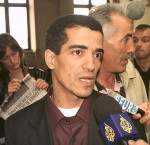
Habib Souaïdia and Algerian state crime
-

Tuareg accuse France of promoting Libya’s latest post-NATO war
-
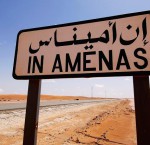
Report on In Amenas: Inquest Cover-Up and Western Involvement in Algerian State Crimes – Jeremy Keenan
-

Who rules Algeria? Part 1: The manoeuvres of General Bouazza Ouassini and other ‘strong men’
-
Algeria: the imprisonment and torture of the regime’s opponents
-

In Amenas: the need for an international enquiry
-
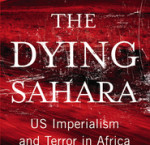
Professor Jeremy Keenan Book Release: The Dying Sahara – US Imperialism and Terror in Africa
-

The In Amenas “cover up”
-
Algeria’s ‘one-eyed’ American general
-

Jeremy H. Keenan




